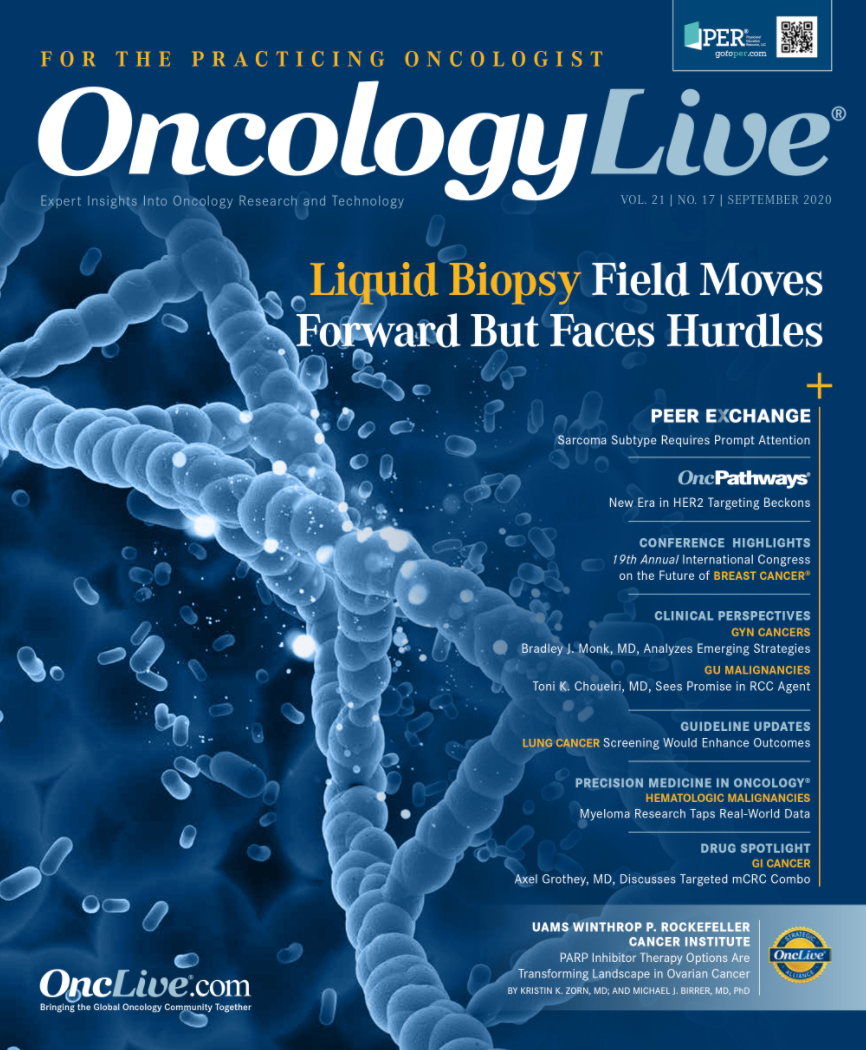Publication
Article
Oncology Live®
First Targeted Regimen Arrives for BRAF V600E-Mutant mCRC
Author(s):
The approval of encorafenib in combination with cetuximab advances the metastatic colorectal cancer paradigm, introducing a biomarker-specific regimen for patients with pretreated BRAF V600E–mutant disease.
Axel Grothey, MD

The approval of encorafenib (Braftovi) in combination with cetuximab (Erbitux) advances the metastatic colorectal cancer (mCRC) paradigm, introducing a biomarker-specific regimen for patients with pretreated BRAF V600E–mutant mCRC. On April 8, 2020, the FDA cleared the doublet therapy for adults with mCRC with a BRAF V600E mutation, detected by an FDA-approved test, after prior therapy.
Findings from the phase 3 BEACON CRC study (NCT02928224), the first to test a dual BRAF/EGFR approach in this patient population, fueled the approval of encorafenib plus cetuximab in this setting. Efficacy data showed that this doublet therapy conferred a significant survival benef it compared with irinotecan plus cetuximab. The median overall survival was 8.4 months (95% CI, 7.5-11.0) in the combination arm versus 5.4 months (95% CI, 4.8-6.6) in the control arm. The median progression-free survival was 4.2 months with the combination and 1.5 months with the control therapy.
In an interview with OncologyLive®, Axel Grothey, MD, a lead author on the BEACON CRC study and director of Gastrointestinal Cancer Research at the West Cancer Center & Research Institute in Germantown, Tennessee, described encorafenib plus cetuximab as the first biomarker-targeted combination in mCRC and discussed its potential to move the needle in the malignancy.
OncologyLive: What patient population is this combination intended for?
Grothey: Encorafenib and cetuximab are approved for patients with BRAF V600Emutant metastatic colorectal cancer who have received prior therapy. These patients have very poor prognoses. About 10% of all metastatic colorectal cancers have the BRAF V600E mutation, which is the strongest molecular prognostic factor that we have in terms of short overall survival. Normally, the median survival is no more than 15 months. We would like therapies to confer a benefit of more than 30 months in an average patient population, so this patient population represents high unmet need.
We know that conventional chemotherapy is not very active, if active at all, in these patients. The other aspect of unmet need comes from the point that these tumors have a very different pattern of metastasis in a lot of patients. Normally we associate colorectal cancer mainly with liver metastasis, but BRAF V600E tumors commonly have peritoneal disease and periaortic lymph node metastases and sometimes liver metastasis.
How does the synergy between encorafenib and cetuximab promote an anticancer effect?
A critical molecular pathway that is activated in colorectal cancer and other tumors is the MAP kinase pathway, which is commonly initiated by a receptor tyrosine kinase, like an EGF receptor, which then activates a chain of G proteins that have an on/off switch potential.
RAS, RAF, MEK, and ERK are all different proteins in this chain of command and the BRAF V600E mutation puts the RAF protein into an on-switch stage, causing it to drive the pathway. We have also learned that when we just use a BRAF inhibitor like encorafenib, there is a feedback loop that eventually activates the EGF receptor and either overrides or bypasses this pathway blockade.
Preclinical translational data showed that a combination of the BRAF inhibitor and an EGFR inhibitor was most active in blocking the BRAF V600E mutation activation to counteract the kind of compensatory reactivation of this pathway.
Does this regimen come with added toxicity?
One of the toxicities we see with cetuximab is an acneiform rash. When you use encorafenib in combination with cetuximab, the rash occurs less frequently than it does with cetuximab alone. Therefore, there is no added toxicity—there is actually a decreased toxicity when it comes to cetuximab.
Overall, when you look at the grade 3 and higher toxicities of this doublet, the reported adverse effects are in the range of about 1% to 4%. Compared with chemotherapy, the combination is much better tolerated, and I believe that this doublet is a good building block that we can use to add additional agents to this regimen, like other biologic agents or even chemotherapy.
How does this agent fit into the treatment paradigm?
This combination will be positioned for most patients in the second-line setting with BRAF V600E. We have to keep in mind there is an overlap between BRAF V600E and MSI [microsatellite instability] status. Tumors that are MSI high are also not infrequently BRAF mutated.
We have 2 targeted treatment options for these patients with MSI-high tumors and BRAF V600E–mutant tumors: No. 1, immunotherapy based on the MSI status, and No. 2, the encorafenib and cetuximab doublet based on BRAF V600E status.
For the non–MSI-high tumors with the BRAF V600E mutation, the current approval would suggest that you start with standard chemotherapy, either FOLFOX or FOLFIRI, or FOLFIRINOX, and then use the BEACON regimen in the second-line setting.
Is there potential for this doublet therapy to have utility beyond its current indication?
We would like to move this regimen into earlier lines of therapy, likely in combination with chemotherapy. There are trials in planning right now that would add this doublet to chemotherapy. This could then also be interesting for patients in the adjuvant setting. We know that BRAF V600E tumors are more common in earlier stages, so we could potentially use this regimen in combination with an oxaliplatin-based therapy.
What does this approval mean for the field?
It is one of those moments in drug development in the management of a tumor that are really historic in the sense that we have the first biomarker- specific targeted combination that really has tremendous efficacy documented in a randomized comparison, setting a new standard of care. This approval shows the power of translating preclinical data into rationally designed combination therapies and, eventually, clinical trials to improve outcomes for patients.





























%20(2)%201-Recovered-Recovered-Recovered-Recovered-Recovered-Recovered-Recovered-Recovered-Recovered-Recovered-Recovered-Recovered-Recovered-Recovered-Recovered-Recovered-Recovered.jpg?fit=crop&auto=format)
%20(2)%201-Recovered-Recovered-Recovered-Recovered-Recovered-Recovered-Recovered-Recovered-Recovered-Recovered-Recovered-Recovered-Recovered-Recovered-Recovered-Recovered-Recovered.jpg?fit=crop&auto=format)
